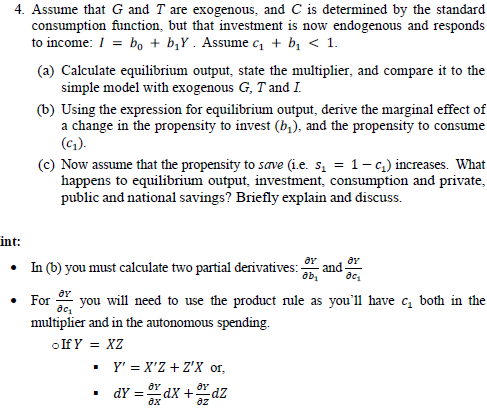Answered step by step
Verified Expert Solution
Question
1 Approved Answer
4. Assume that G and T are exogenous, and C is determined by the standard. consumption function, but that investment is now endogenous and

4. Assume that G and T are exogenous, and C is determined by the standard. consumption function, but that investment is now endogenous and responds to income: I = b + bY. Assume c + b < 1. (a) Calculate equilibrium output, state the multiplier, and compare it to the simple model with exogenous G, T and I. (b) Using the expression for equilibrium output, derive the marginal effect of a change in the propensity to invest (b), and the propensity to consume (c). (c) Now assume that the propensity to save (i.e. s = 1-c) increases. What happens to equilibrium output, investment, consumption and private, public and national savings? Briefly explain and discuss. int: In (b) you must calculate two partial derivatives:- and For you will need to use the product rule as you'll have c both in the multiplier and in the autonomous spending. If Y = XZ Y'X'ZZ'X or, dy = 0xdX + odz
Step by Step Solution
There are 3 Steps involved in it
Step: 1
Lets break down the problem step by step Part A Equilibrium Output and Multiplier We have the consumption function C c0 bYd where Yd is endogenous inc...
Get Instant Access to Expert-Tailored Solutions
See step-by-step solutions with expert insights and AI powered tools for academic success
Step: 2

Step: 3

Ace Your Homework with AI
Get the answers you need in no time with our AI-driven, step-by-step assistance
Get Started


